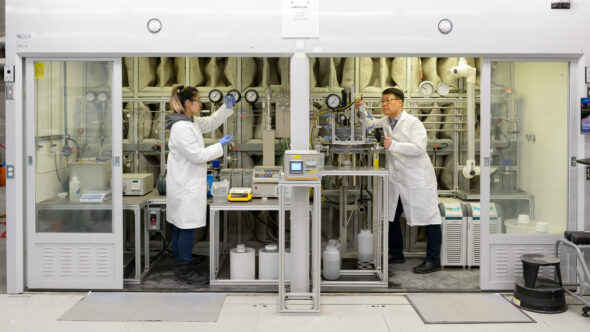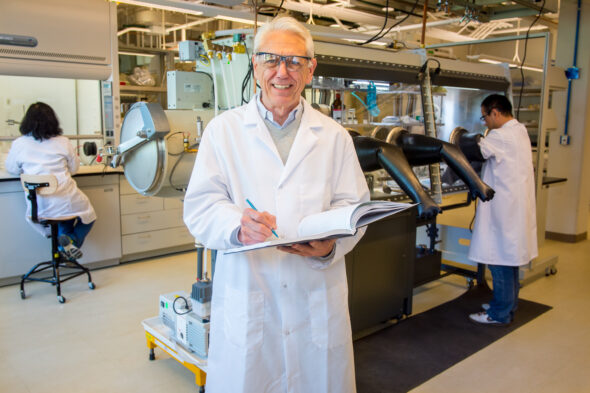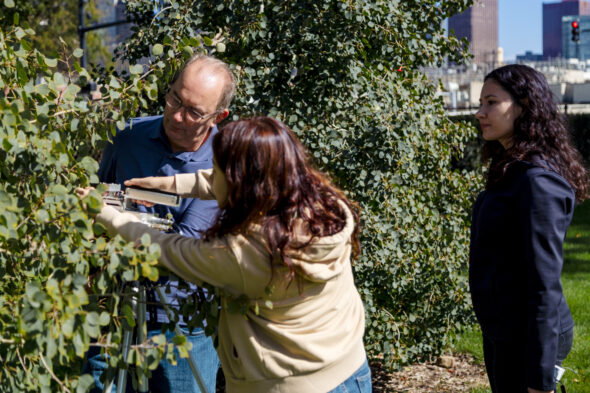New institute bonds UIC and Argonne National Laboratory on research and education

Just 20 miles separate Argonne National Laboratory in Lemont, Illinois, and the downtown campus of University of Illinois Chicago. But starting this year, the research mission of the two Chicagoland institutions that formed in the wake of World War II will coalesce in a new science innovation and education partnership.
The George Crabtree Institute for Discovery and Sustainability, named for the late, renowned physicist who held positions at both Argonne and UIC, will launch new research collaborations and training in STEM fields. The institute will be built around a common vision: to advance scientific knowledge and train a diverse generation of future pioneers in clean energy, computing, urban development and other critical areas.
“The Crabtree Institute will create potent new opportunities for collaboration and education between Argonne and UIC,” said UIC Chancellor Marie Lynn Miranda. “It will expand access for our faculty and students to resources and programs at the cutting edge of research and discovery, advancing our mission to improve the world, serve our community and provide transformative education.”
The new partnership combines the unique strengths of a U.S. Department of Energy laboratory and Chicago’s only public research university. It will spearhead collaborative research for UIC faculty and Argonne staff, research training programs for students, community-based research initiatives and other activities.
Leading these efforts will be founding co-directors Jordi Cabana and Michael E. Papka, UIC faculty members who also hold appointments at Argonne. Both said they were inspired by George Crabtree’s legacy of multidisciplinary collaboration and inclusive education.
Fitting tribute to a beloved scientist
Crabtree earned his doctoral degree in 1974 as one of the first doctoral graduates of the UIC Department of Physics. He took classes at night while working days at Argonne, where he had worked as an undergraduate intern.

In his early research, he focused on the behavior of superconductors in high magnetic fields. That work eventually won him the Kamerlingh Onnes Prize, a prestigious international award. As his career progressed, he grew passionate about using science to fight climate change and transitioned his research focus to materials for next-generation batteries and clean energy.
In 2012, Crabtree was named director of the Joint Center for Energy Storage Research, a Department of Energy innovation hub developing new approaches for high-performance batteries. The coalition of 20 research organizations included Argonne and UIC, which Crabtree joined as a professor of physics in 2010.
In an interview with the UIC College of Liberal Arts and Sciences magazine, Crabtree said his return to UIC was motivated by a strong belief in the importance of public education.
“Public research universities play a key role in society — they draw students from the widest and most diverse backgrounds, they expose these students to high-level thought leaders and they often produce outstanding researchers, teachers, legislators and businesspeople that otherwise would be lost to society,” he said.
Crabtree’s leadership of the Joint Center for Energy Storage Research stretched far beyond laboratory experiments, his collaborators said. He prided himself on building interdisciplinary and multi-institutional collaborations, involving the broader community in the research process, engaging with students at all levels and welcoming them into scientific careers.
Those same philosophies will form the foundation of the new Crabtree Institute, which honors his legacy as a scholar, educator and leader. The institute will be committed to excellence in cutting-edge research, educational enrichment, sustainability, diversity, equity and accessibility.
“George wasn’t just an executive; he was a person that inspired people,” said Cabana, professor of chemistry at UIC and a group leader in the materials science division at Argonne. “He was good at seeing the dots and helping the dots connect.”
Paul Kearns, laboratory director at Argonne, agreed.
“George was a revered and beloved scientist and educator, so it’s fitting that a partnership like this between Argonne and UIC would carry on his legacy,” said Paul Kearns, laboratory director at Argonne. “I look forward to the impact this institute will make on multiple important fronts.”
A new chapter in UIC-Argonne collaboration
The Crabtree Institute will support and accelerate collaboration between Argonne and UIC. But the two institutions already have a productive partnership.
In addition to directing the Joint Center for Energy Storage Research, Crabtree was instrumental in establishing the Next Generation Electrochemistry workshop in 2016. The annual gathering, organized in partnership with Argonne, brings promising graduate students and postdoctoral researchers from around the country to the UIC campus each summer for a week of lectures, discussions and tours. The program is now run by Cabana, one of the Crabtree Institute co-directors.
Crabtree was also involved in the Community Research on Climate and Urban Science project, established in 2022 by a $25 million grant the Department of Energy gave to Argonne, UIC and other academic and community partners.

The initiative is building an urban integrated field laboratory to study climate change and its impact on neighborhoods and regions. Activities include installing sensor nodes (one is due to be installed on the UIC campus this year) to monitor weather, pollution and the influence of urban infrastructure on climate. The data will lead to more detailed models of local climate and provide a resource for communities advocating for improved climate and green space.
UIC and Argonne are also members of the Great Lakes ReNEW regional innovation engine, a National Science Foundation effort which will coordinate research and workforce development related to water resources in the region, and C-STEEL, a Department of Energy “Earthshot” developing technologies to reduce carbon emissions from the steelmaking industry.
Many other UIC-Argonne collaborations use the unique scientific resources of both locations. Argonne is home to the Advanced Photon Source, a high-energy X-ray facility that allows scientists to study matter’s molecular structure. Mark Schlossman, professor of physics at UIC, leads ChemMatCARS, a specialized beamline at Advanced Photon Source for studying crystallized small molecules and liquid interfaces.
The Argonne Leadership Computing Facility, directed by Crabtree Institute co-director Papka, gives scientists access to some of the world’s most powerful supercomputers for science. UIC researchers recently used these resources to generate and test new materials for carbon capture and explore a key drug target for HIV. Those capabilities will only expand with the upcoming debut of Aurora, an exascale supercomputer capable of running more than a billion billion calculations per second.

“It’s an enabler,” said Papka, who is also professor of computer science at UIC and senior scientist and deputy associate laboratory director at Argonne. “Aurora will enable science and technology in what users think are the traditional realms of modeling and simulation but also enable advances in data science and artificial intelligence. This will help us better understand diseases and allow supercomputers to be used in the humanities. It will bring a whole new class of users that we haven’t seen on our supercomputers in the past.”
Conversely, Argonne scientists will benefit from resources unique to UIC such as the electron microscopy core, a collection of state-of-the-art instruments for examining materials at the nanoscale. Its new transmission electron microscope, arriving later this year, will be the first of its kind in the United States and allow users to examine specimens in an environment free of magnetic fields.
“I think the institute will be hugely beneficial for both Argonne and UIC scientists,” said Robert Klie, professor and head of the UIC Department of Physics and director of the electron microscopy core at UIC. “We each have expertise that the other does not have, and both sides will be able to use the world-class instrumentation at UIC and Argonne as part of the institute. It’s going to be a two-way street.”
